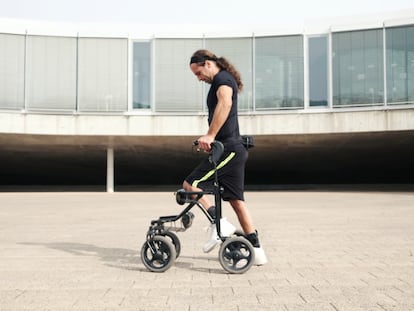Leukemia patient declared ‘cured’ after success of CAR-T immunotherapy
The story of an individual who responded exceptionally well to an experimental treatment offers hope for other cancer sufferers despite the significant challenges that lie ahead

In 1996, Doug Olson, a 49-year-old doctor with a wife and four children, received some bad news. His own doctor at the Hospital of the University of Pennsylvania in the US, David Porter, told him he had chronic lymphocytic leukemia, a type of blood cancer. The disease progresses slowly, so at first he was simply monitored, but six years after diagnosis he had to begin chemotherapy. The first round of treatment allowed Doug to live a more or less normal life for five more years, but the next round was not as effective and only gave him a respite of three more years. In 2009, a full 13 years after his diagnosis, the tumor cells were multiplying again and he had to consider other options. One of them was a bone marrow transplant. However, they could not find a suitable donor. So Porter offered him an alternative: he could join a clinical trial that was about to begin. Olson read the protocol for the trial and thought it might work.
The experimental treatment was a new type of cancer immunotherapy. The principle of these therapies is to combat the cancer’s capacity to prevent our immune system cells from identifying it as a threat and destroying it. The technique, known as CAR-T (chimeric antigen receptor T-cell therapy), involves taking blood from patients, selecting T-lymphocytes – a type of white blood cell that defends the body against all kinds of attacks – and genetically engineering them in a laboratory to recognize and annihilate tumor cells. At first Olson felt nothing, but two weeks later he began to feel ill with severe flu-like symptoms. This was a sign that the therapy had kicked in. Now, more than a decade later, the leukemia is still in remission.
Oncologists are very reluctant to utter the term “cure” when it comes to cancer. However, at a news conference to present data from 10 years of follow-up on two patients treated for leukemia with CAR-T – one of them being Olson – Carl June, an immunologist at the University of Pennsylvania who led that trial, used the term several times. “Based on these results, we can say that CAR-T can cure patients; 10 years on, no leukemia cells could be found in their blood,” he said.
Joseph Melenhorst, an immunologist researcher at the University of Pennsylvania and a co-author of the follow-up paper published in the journal Nature on February 2, explained that 10 years after injecting the modified lymphocytes into patients, they have continued to reproduce and maintain their ability to kill cancer cells.
CAR-T therapy is one of the most promising therapies in recent years for liquid tumors and has managed to prolong the lives of many patients who had run out of options. In December 2021, Barcelona’s Clínic Hospital presented the results of this therapy in 30 patients with multiple myeloma. Of these, 18 had gone into complete remission. Carlos Fernández de Larrea, one of the doctors who led that trial, explained at the time that complete remission does not mean the cancer is cured and, with regard to the results published on February 2, he clarified that a duration of 10 years “is quite exceptional.” However, he points out that the real interest of the results lies in following up the behavior of these cells over the decade, and “learning from it that so it can be replicated in more patients.”
I thought the cells could hold out for a month or two, so to see them there 10 years later is a really pleasant surpriseDavid Porter, Hospital of the University of Pennsylvania
In the two individuals studied since 2010, the genetically modified cells continued to reproduce and maintained their ability to control the leukemia. In most cases, the CAR-T cells become less numerous in the blood over time or else the tumors mutate, allowing them to escape recognition. In the cases presented in Nature, the researchers observed a surprising phenomenon. The work of CD8 lymphocytes – crucial killers at the start of the treatment to destroy tumor cells – was subsequently reinforced by the work of CD4 lymphocytes, which have a more controlling role, and which could be useful in restricting the spread of the disease. “This happened randomly, but I wish we could design a molecular strategy so that all CAR-Ts would act like this,” said Fernández de Larrea.
CAR-T therapies are currently an option for patients who have run out of options. In tumors such as leukemias or lymphomas, chemotherapy or some first-line immunotherapies can buy valuable time, as in the case of Doug Olson.
Regarding the new CAR-T therapy, Porter noted that “it works very well in the patients that it works in, but the biggest disappointment is that it doesn’t work for everyone. This study is starting to show us how and why it works and can help us make it work in more people.” In any case, the results have far exceeded the expectations with which he started the first CAR-T trial in 2010. “At that time, I didn’t think it was going to be a remedial therapy,” he said. “I thought the cells could hold out for a month or two, so to see them there 10 years later is a really pleasant surprise. The opposite has happened with this therapy than with most – it ended up working better in humans than in the mice that were used in earlier trials.”
Like all other cancer treatments, CAR-T therapy has side effects that need to be managed. The flu-like symptoms Olson experienced are related to the release of cytokines triggered by activating the immune system. When that process gets out of control, as it does in some Covid-19 patients, the immune response can become a threat to the patient. Drugs such as tocilizumab, a monoclonal antibody that also prevents complications in severe coronavirus infections, are used to control this reaction. Neurological effects also pose a risk, so these therapies must be undertaken in specialized hospitals. Finally, as Carl June pointed out, CAR-T recipients must be monitored for 15 years to ensure that the gene editing applied to the lymphocytes has no undesirable side effects on the patients.
There is of course much room for improvement regarding this new immunotherapy, but the story of the two patients presented in Nature offers hope. There are still challenges such as reducing the treatment’s cost, which can be around €300,000 ($343,000) per patient with commercially approved treatments. The public alternatives, such as the one developed by Barcelona’s Clínic Hospital, are in the realm of €90,000 ($102,880) – also a substantial amount. However, experts are confident that, as often happens, the industrialization of the process will reduce the price.
Finally, efforts are also being made to move the therapy beyond liquid tumors. The characteristics of cancers such as colon or lung cancer, in which cancer cells are integrated with healthy ones, make it more difficult to design a targeted attack such as the one carried out by CAR-T cell therapy. However, looking back at the long fight against cancer in which the first treatments also began with liquid tumors and later worked on solid tumors, there are grounds for optimism.
Tu suscripción se está usando en otro dispositivo
¿Quieres añadir otro usuario a tu suscripción?
Si continúas leyendo en este dispositivo, no se podrá leer en el otro.
FlechaTu suscripción se está usando en otro dispositivo y solo puedes acceder a EL PAÍS desde un dispositivo a la vez.
Si quieres compartir tu cuenta, cambia tu suscripción a la modalidad Premium, así podrás añadir otro usuario. Cada uno accederá con su propia cuenta de email, lo que os permitirá personalizar vuestra experiencia en EL PAÍS.
¿Tienes una suscripción de empresa? Accede aquí para contratar más cuentas.
En el caso de no saber quién está usando tu cuenta, te recomendamos cambiar tu contraseña aquí.
Si decides continuar compartiendo tu cuenta, este mensaje se mostrará en tu dispositivo y en el de la otra persona que está usando tu cuenta de forma indefinida, afectando a tu experiencia de lectura. Puedes consultar aquí los términos y condiciones de la suscripción digital.
More information
Últimas noticias
The life of a delivery driver in China: ‘Many people don’t know how an order can arrive at their home in just one day’
Maude Apatow, from acting in ‘Euphoria’ to directing: ‘There are many films that you can tell weren’t written by someone young’
Helen Levitt, the photographer who captured the theater of the everyday
The guardians of the meteorites of the Argentine Chaco
Most viewed
- Christian Louboutin: ‘Young people don’t want to be like their parents. And if their parents wear sneakers, they’re going to look for something else’
- US sanctions against jailed cartel leader ‘El Marro’ highlight Mexico’s lack of control over its prisons
- Cartels in Mexico take a leap forward with narco-drones: ‘It is criminal groups that are leading the innovation race’
- Liset Menéndez de la Prida, neuroscientist: ‘It’s not normal to constantly seek pleasure; it’s important to be bored, to be calm’
- ‘El Limones’ and the growing union disguise of Mexican organized crime











































